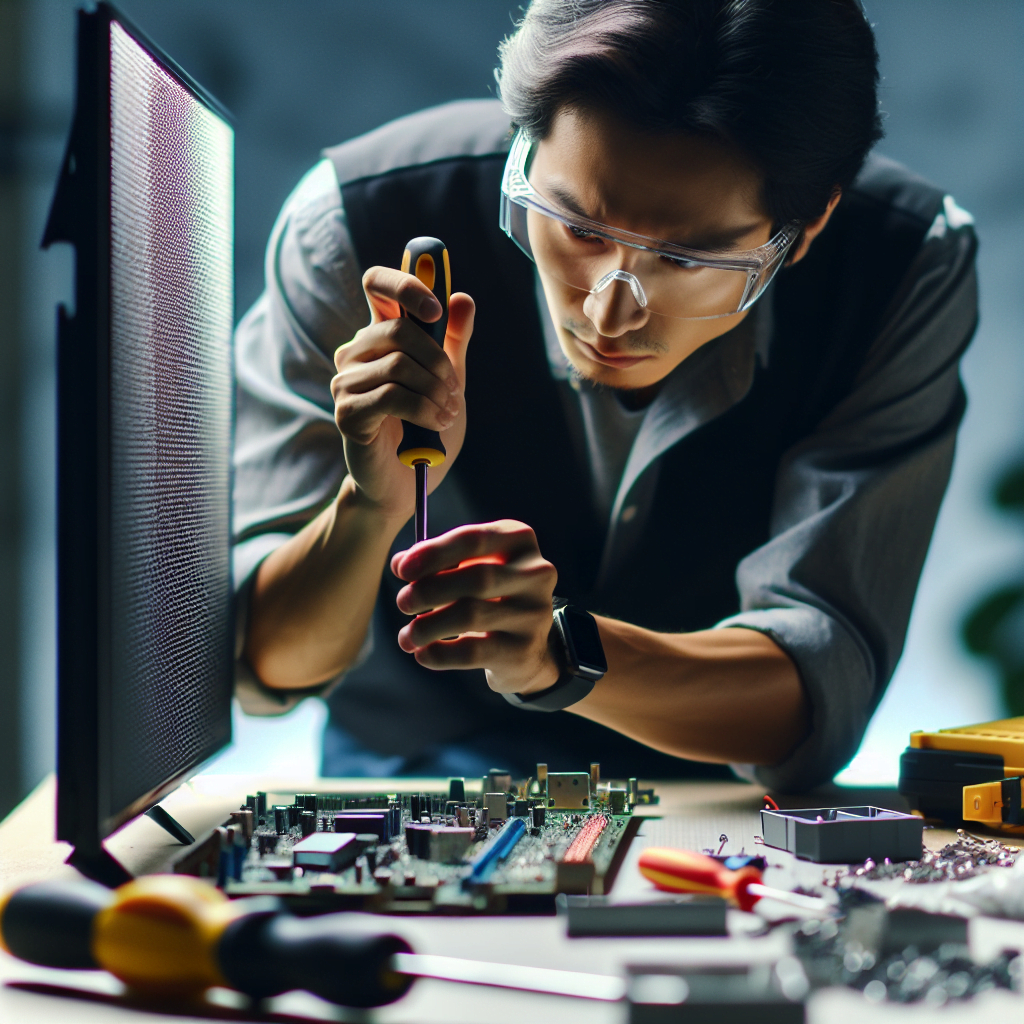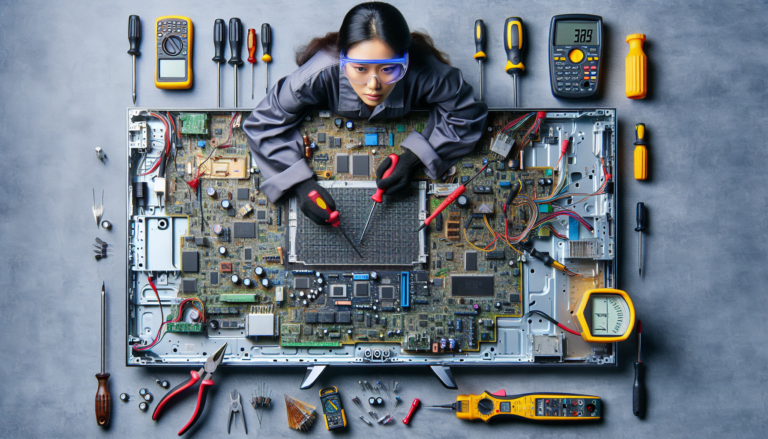LED televisions have gained popularity in times taking the place of older LCD and plasma models. Their sleek design, energy efficiency, and impressive picture quality have made LED TVs a staple in households. However, like any device LED TVs can encounter issues over time that may require specialized repair services.
When faced with a problem, with your LED TV it is crucial to ensure repair to maintain its performance. In this guide provided by LED TV Panel Repair, we will explore the problems associated with LED TVs and how you can address them. Whether dealing with issues, panel malfunctions, power supply troubles, or other faults this article aims to assist you in diagnosing and resolving typical LED TV repairs.
Backlight Systems, in LED Televisions
To effectively tackle repairs related to LED TVs it is essential to understand how the backlighting system functions. There are two types of backlights utilized in LED televisions;
CCFL Backlights:
The original LED TVs used cold cathode fluorescent lamps (CCFLs) for backlighting. CCFL tubes are placed along the edges of the display. A diffusion panel helps spread this light evenly across the screen.
To power the CCFL tubes, an inverter board converts the DC voltage to a high-frequency AC output. The inverter regulates the lamp’s brightness and acts like a power supply.
LED Backlights
Newer LED TVs now use an array of LEDs directly behind the panel for backlighting. This allows even better control over localized dimming zones.
The LEDs require a driver circuit to operate. This converts the main DC voltages to the low voltages needed for the LEDs. It also controls LED dimming.
In both designs, the backlight is one of the most failure-prone subsystems. Backlight issues cause many common LED TV problems.
Diagnosing Backlighting Problems on an LED TV
Because the backlight provides illumination for the entire display panel, any issues can lead to visible symptoms like:
- Complete lack of image/no backlight
- Uneven backlighting across the screen
- Black spots or lines on display
- Excessive light bleeding from edges
Do These First Steps to Isolate Backlight Issues:
- Inspect the TV in a dark room to check for any backlight glow.
- Toggle brightness settings to confirm the backlight is unresponsive.
- Connect external sources like DVD players to rule out internal TV faults.
Once a backlight problem is confirmed, you can begin thorough troubleshooting:
For CCFL Backlights:
- Check for cracked/broken CCFL tubes.
- Look for blackened/burnt-out tubes.
- Inspect the inverter board for damaged components.
- Check cable connections between the inverter and lamps.
For LED Backlights
- Closely inspect LED strips for dead or dim LEDs.
- Check cables from the LED driver board to LED strips for damage.
- Use a multimeter to check driver board outputs for correct voltages.
- Examine the driver board for burnt-out components.
Repair Options for Backlight Issues:
- For the CCFL backlight, replacing the inverter board or individual CCFL tubes may resolve the issue.
- For LED backlight, swap out only bad LED strips. Or replace the entire LED backlight panel for widespread issues.
- Also, replace the driver board itself if component-level repair is not possible.
Proper diagnosis to find the faulty backlight components is key. However, the repair options are relatively simple in most cases.

Fixing Display Panel Issues
The LED panel itself is made up of different layers and components that produce the picture. Common problems with LED panels include:
- Dead pixels – small dark or bright spots
- Cracked or broken outer glass
- Internal damage causing color distortion or lines
Do These Quick Checks First:
- Run pixel test patterns to identify dead pixel locations.
- Check for any external cracks or physical damage.
- Inspect cable connections to the panel.
To Further Troubleshoot Panel Issues:
- Use the flashlight at an angle to spot internal cracks/damage.
- Apply gentle pressure to see if the issue distorts.
- Check driver voltages and signaling to the panel.
Repair Options for Panel Issues:
- For a few dead pixels only, a spot repair or dabbing liquid filler into pixels can be fixed.
- If cracked glass, carefully replacing the front glass layer only is possible.
- However, replacing the entire LED panel assembly may be needed for substantial panel failure.
Panel issues take some finesse to troubleshoot. However, carefully examining the symptoms and using targeted testing can isolate the fault.
Troubleshooting LED TV Power Supply Problems
The power supply unit (PSU) generates the different voltage rails needed to power all the LED TV circuitry. Common power supply issues include:
- Dead – no power at all
- Turns off after seconds
- Power cycles on/off when hot
- Flickering or distorted image
First Steps for Power Testing:
- Confirm AC input voltage present to PSU.
- Check standby voltages are present.
- Inspect the power board for discoloration or burnt smells.
To Thoroughly Test the Power Supply:
- Check outputs with a multimeter for correct voltages/ripple.
- Visually inspect filters/caps for bulging or leaks.
- Scan the board closely for burnt components.
Repairing Power Supply Issues:
- Resolving burnt-out capacitors or fuses often fixes power cycling errors.
- Replace any bulging or leaking caps on the filter bank circuitry.
- If pulsating/dirty DC outputs may need more extensive repair.
- For suspected component failure, power board replacement is recommended over complex chip-level repair.
Thorough power supply testing isolates whether the issue is from incoming AC or the PSU board itself. Quality replacement parts can often get LED TVs powering back up.
Fixing Mainboard Problems
The mainboard, or motherboard, is the central processing module of the TV. It controls critical functions like:
- Video and audio processing
- Input selection and control
- Smart TV/menu features
If the mainboard experiences problems, typical symptoms are:
- No audio or video display
- HDMI/input connection issues
- Apps and smart TV features are not functional
Preliminary Mainboard Testing:
- Reseat all wire harness connections.
- Closely inspect the board for burnt marks or damaged components.
- Boot into the service menu to test basic functionality.
Advanced Mainboard Troubleshooting:
- Check power rail voltages and signals with a multimeter.
- Probe signals like clocks and data buses for issues.
- Research board power sequencing and operation.
Fixing Mainboard Faults:
- Attempt to reflow any cracked solder joints around BGA chips.
- Repair damaged power filter capacitors if present.
- Replace burnt-out fuses with proper replacements.
- Otherwise, full mainboard replacement is recommended.
With intricate, densely packed PCB designs, mainboard issues often require board replacement. Match model numbers carefully when ordering replacements.

Repairing CCFL Backlight Inverter Problems
In older CCFL backlit LED TVs, the inverter board powers the CCFL tubes. Symptoms of a faulty inverter include:
- Backlight flickering or blinking
- Uneven backlight illumination
- Dead backlight
Testing the Inverter
- Check output voltages/waveforms with an oscilloscope.
- Look for swollen/leaking capacitors.
- Inspect closely for any burnt components.
Fixing Inverter Issues
- Repair or replace faulty capacitors if found.
- Replace transformers or FETs if damaged.
- Replace the entire inverter board if repair is not feasible.
While limited component repair is possible, inverter board replacement is usually recommended for reliability. And use caution due to the high voltages present.
Software and Firmware Troubleshooting
The processors and memory chips on the TV’s boards run complex firmware and software that control the TV. Problems caused by software faults include:
- TV freezing and crashing
- Apps not loading
- Poor picture quality
Before Software Troubleshooting:
- Perform a factory reset to clear any software glitches.
- Check for available firmware updates and install the newest version.
Further Software Diagnosis:
- Try disconnecting inputs and external devices to isolate the issue.
- Boot into the service/factory menu to change settings.
- Research factory reset sequences for your specific TV model.
Additional Software Fixes:
- Some firmware fixes may require a bootable USB update procedure.
- For stuck devices or processes, remove power for 1 minute before retesting.
- If the issue persists after resets, may require replacing control boards.
Logical software troubleshooting steps can resolve many apparent faults without hardware repair. But don’t overlook electrical issues that can mimic software glitches.
Consult a Professional for Tricky LED TV Repairs
We hope this guide has provided a helpful starting point for troubleshooting and repairing common issues with LED TVs. However, some faults require advanced soldering skills or equipment only available in electronics repair shops.
Our technicians at LED TV Panel Repair have over 20 years of experience servicing all brands of LED, LCD, and smart TVs. We have the technical expertise to resolve even complex issues like:
- Advanced mainboard-level repairs
- Replacement of fragile display panel layers
- Micro soldering of surface mount components
- Access to proprietary service manuals and test modes
Our affordable repair rates and fast turnaround times make it worthwhile to seek professional assistance when needed. We offer pickup and return delivery for your convenience.
For LED TV owners in Kathmandu, don’t hesitate to contact us about your repair needs. Our dedicated service center near Pako, New Road employs highly trained technicians equipped to fix LED TVs properly and get them back in working order.
Conclusion
We hope this guide has removed some of the mystery around diagnosing and repairing common LED TV faults. While tempting, don’t simply replace the TV at the first sign of trouble. With thoughtful troubleshooting and some basic repair skills, many issues can be resolved at a fraction of the cost of replacement.
LED TV technology has many benefits but also unique complexity. If needed repairs exceed your comfort level, leverage the expertise of a professional service company. Proper diagnosis paired with quality parts can often breathe new life into a faulty LED TV.




